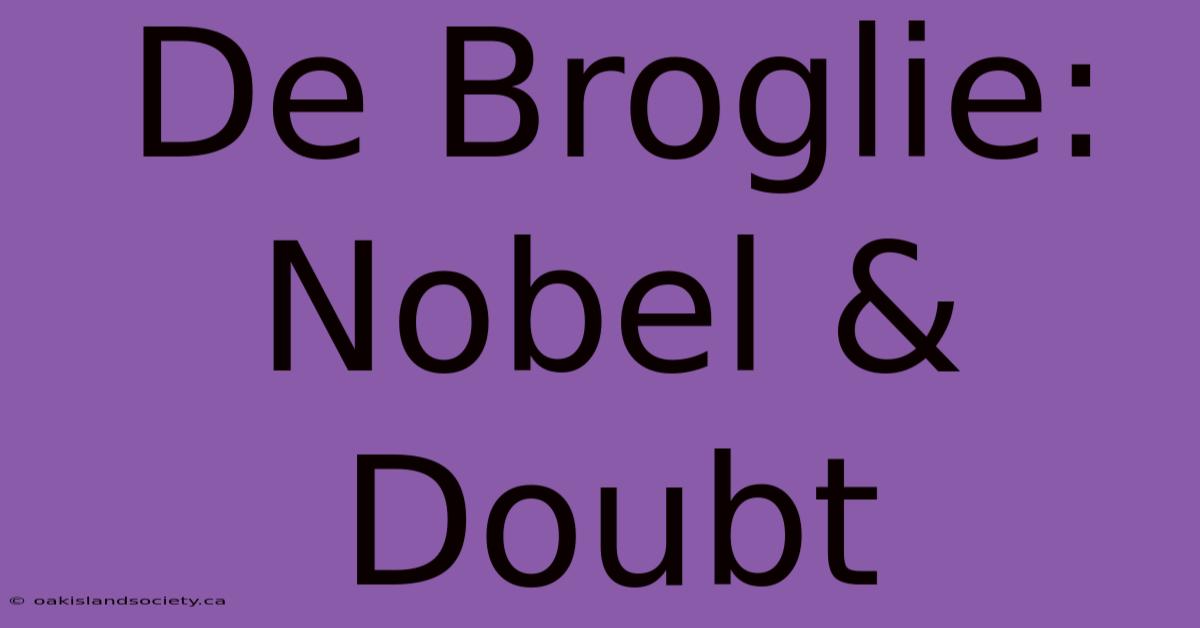De Broglie: Nobel Prize and Lingering Doubts
Introduction: Louis de Broglie's revolutionary wave-particle duality hypothesis earned him a Nobel Prize, yet some aspects of his theory continue to spark debate. Recent advancements in quantum mechanics have prompted a re-examination of certain fundamental aspects, leading to renewed interest in both the successes and limitations of his groundbreaking work.
Why This Topic Matters: De Broglie's contribution fundamentally shifted our understanding of matter and energy. His work laid the groundwork for quantum mechanics and has had profound implications for various fields, including nanotechnology and materials science. Exploring the lingering doubts surrounding his theory allows for a deeper understanding of the complexities and ongoing evolution of quantum physics.
Key Takeaways:
| Aspect | Description |
|---|---|
| Wave-Particle Duality | Matter exhibits both wave-like and particle-like properties. |
| Matter Waves | All matter possesses an associated wavelength, inversely proportional to momentum. |
| Experimental Verification | Electron diffraction experiments confirmed de Broglie's hypothesis. |
| Ongoing Interpretations | Debates continue regarding the precise nature of wave-particle duality. |
De Broglie's Wave-Particle Duality
Introduction: De Broglie's 1924 PhD thesis proposed that all matter possesses wave-like properties, extending the wave-particle duality already observed for light. This revolutionary idea, initially met with skepticism, became a cornerstone of modern quantum mechanics.
Key Aspects:
- Wavelength Calculation: De Broglie's equation, λ = h/p (where λ is wavelength, h is Planck's constant, and p is momentum), quantifies the wavelength associated with any particle.
- Experimental Confirmation: Experiments demonstrating electron diffraction provided crucial evidence supporting de Broglie's hypothesis. The wave-like behavior of electrons was clearly observed through interference patterns.
- Implications for Quantum Mechanics: De Broglie's work was instrumental in developing the Schrödinger equation, a fundamental tool in quantum mechanics.
In-Depth Discussion: De Broglie's hypothesis unified the seemingly disparate wave and particle natures of light and matter. It successfully explained the quantization of electron orbits in the Bohr model, providing a more comprehensive and fundamental understanding of atomic structure.
The Pilot Wave Theory: A Connection Point
Introduction: De Broglie initially proposed a "pilot wave" interpretation of quantum mechanics, where the wave guides the particle's motion. This contrasts with the Copenhagen interpretation, which emphasizes the probabilistic nature of quantum phenomena.
Facets:
- Role of the Wave: In the pilot wave theory, the wave function is a real physical entity that guides the particle.
- Examples: The double-slit experiment can be explained by the pilot wave guiding the particle through one slit or the other.
- Risks: The pilot wave theory faces challenges in accounting for entanglement and non-locality.
- Mitigation: Ongoing research explores modifications and refinements of the pilot wave theory to address these challenges.
- Impacts: The pilot wave theory offers an alternative perspective on quantum mechanics, challenging the prevailing probabilistic interpretation.
Summary: While not the dominant interpretation, the pilot wave theory showcases the ongoing debate surrounding the foundational aspects of quantum mechanics and the limitations of a complete understanding even of de Broglie's own work.
FAQ
Introduction: This section addresses common questions concerning De Broglie's work and its implications.
Questions:
- Q: What is the significance of de Broglie's wavelength equation? A: It provides a quantitative link between the momentum of a particle and its associated wavelength, demonstrating the wave-particle duality.
- Q: How was de Broglie's hypothesis experimentally verified? A: Electron diffraction experiments showed interference patterns, proving electrons exhibited wave-like behavior.
- Q: What is the difference between the pilot wave and Copenhagen interpretations? A: The pilot wave suggests a deterministic, guided wave, whereas Copenhagen emphasizes probabilistic wave function collapse.
- Q: Does de Broglie's theory apply to macroscopic objects? A: Yes, but the wavelength is incredibly small and thus undetectable for macroscopic objects.
- Q: What are the limitations of de Broglie's theory? A: It doesn't fully address the complexities of quantum entanglement and measurement problems.
- Q: What is the ongoing research related to de Broglie's work? A: Research continues on refining interpretations of wave-particle duality and exploring the implications for quantum computing and other fields.
Summary: The FAQs highlight both the strengths and limitations of De Broglie's revolutionary ideas, demonstrating the continuing evolution of our understanding of quantum mechanics.
Tips for Understanding De Broglie's Work
Introduction: These tips will aid in grasping the core concepts and implications of de Broglie's wave-particle duality.
Tips:
- Visualize the wave: Imagine matter as having both a particle-like and a wave-like nature, similar to light.
- Understand the equation: Familiarize yourself with de Broglie's equation (λ = h/p) and its implications.
- Explore electron diffraction: Research experiments that demonstrate the wave-like behavior of electrons.
- Compare interpretations: Compare and contrast the pilot wave and Copenhagen interpretations of quantum mechanics.
- Consider the scale: Remember that the wave nature is more pronounced at smaller scales.
- Relate to other quantum phenomena: Connect de Broglie's work to other concepts like quantum tunneling and superposition.
Summary: By employing these tips, you can gain a deeper and more nuanced appreciation of De Broglie's groundbreaking contributions to quantum physics.
Resumen (Summary)
This article explored Louis de Broglie's revolutionary contribution to quantum mechanics, highlighting his wave-particle duality hypothesis and its profound implications. While his work earned him a Nobel Prize and fundamentally altered our understanding of the universe, debates continue surrounding the precise interpretation of his theory, particularly regarding the pilot wave interpretation and its comparison to the Copenhagen interpretation. Further research promises to continue refining our understanding of this crucial area of physics.
Mensaje final (Closing Message)
De Broglie's legacy continues to inspire and challenge physicists. His work serves as a testament to the power of innovative thinking and the ever-evolving nature of scientific understanding. Further exploration of wave-particle duality and related concepts promises exciting new discoveries and a deeper understanding of the quantum world.

